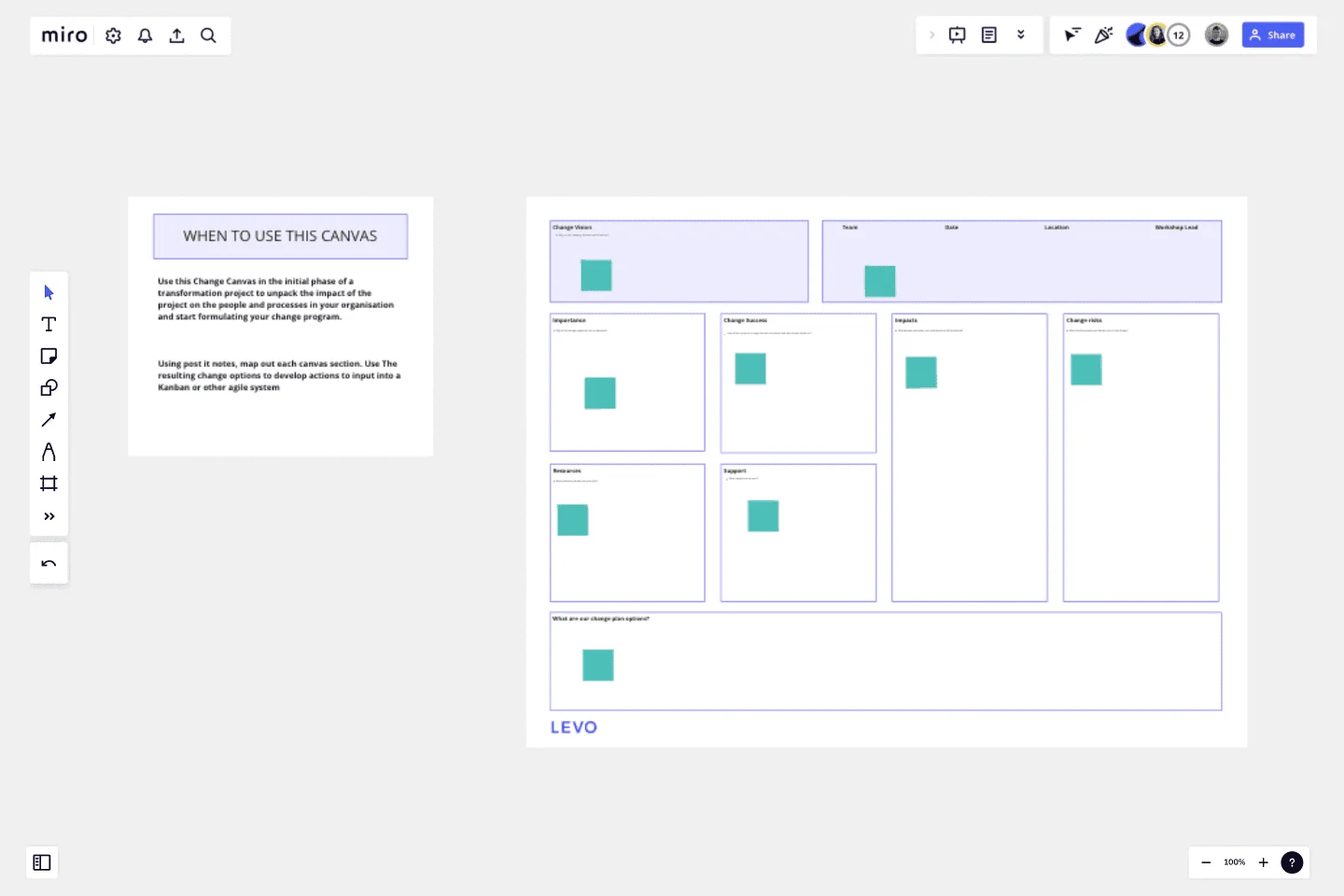Change Canvas
Navigate change successfully with the Change Canvas template. Map stakeholders, goals, and actions for transparent and collaborative change management.
This canvas will help you work through change planning quickly as it focuses on the main areas of execution.
Work through each aspect of the change canvas and then create your ideas for change - these can then be added to a kanban or other agile tool.
Change Vision: What are we trying to achieve with this change? 10 mins
Importance: Why is this change important to the business? What will happen if we don't change? 10 mins
Change success: What are the change success measurements? 10 mins
Resources: What resources are already available? 5 mins
Support: What further help would be needed to be successful? 10 mins
Impacts: What teams, processes and functions will be impacted by this change? 10 mins
Risks: What could be some adverse or unintended consequences? 15 mins
Plan: What initiatives can we start to execute now? 10 mins
This template was created by Rebecca McDermott.
Get started with this template right now.
Agile Transition Plan Template
Works best for:
Agile Methodology, Agile Workflows
An Agile transformation roadmap can help you, your team, and your organization transition from rigid compliance-heavy methods to the more flexible Agile way of doing things incrementally. From requirements to integrations to security, you can map out your organization's moving parts as “swim lanes” that you can then update regularly. Use your roadmap as a way to tell the story of how you see your product growing over a period of time. Get buy-in without overselling and keep your roadmap simple, viable and measurable. By using an Agile transformation roadmap, you can avoid getting bogged down in details and instead invest in big-picture strategic thinking.
Editorial Calendar Template
Works best for:
Marketing, Strategic Planning, Project Planning
If your company is like most, content is a big thing. You create more of it (and a lot faster) than you create almost anything else. It includes blogs, newsletters, social media posts, ads, and more—and it requires ideating, writing, editing, and publishing. That’s why every content team needs an editorial calendar. The template will let you easily create a calendar that empowers your team to plan strategically, keep things organized (by content type, writer, channel, and delivery date), and finalize/post all content on schedule.
Kanban Pizza Game
Works best for:
Agile, Kanban
The Kanban Pizza Game is an interactive way for teams to learn and apply Kanban principles. By simulating a pizza delivery process, teams experience how to visualize work, limit work in progress, and optimize flow. Through rounds of iteration and reflection, participants gain insights into continuous improvement and lean thinking, fostering collaboration and driving efficiency. Get ready to slice through inefficiencies and deliver value faster with the Kanban Pizza Game!
Scrum Task Tracker (with CSV export)
Works best for:
Kanban Boards, Agile Methodology, Agile Workflows
Scrum Task Tracker template combines Kanban and Scrum methodologies to enhance project management and tracking. With features like CSV export, teams can capture and analyze task data for insights into performance and improvement areas. This template fosters transparency and accountability, enabling teams to track sprint progress, identify blockers, and adapt their approach to maximize efficiency and deliver value consistently.
Change Control Process Template
Works best for:
Agile Methodology, Documentation, Product Management
You can predict, research, and plan for every detail of a project to go a certain way—then along comes the unforeseen and modifications are needed. That’s when a change control process comes into play. It helps define the right steps to take, gives stakeholders full visibility, and reduces the chances of errors and disruption. And this template is easy to use and highly effective—for ensuring that proposed changes are reviewed before they’re implemented, and empowering teams to veto changes that might prove unnecessary or disruptive.
Goal Tracker Template for Small Businesses
Works best for:
Kanban Boards, Agile Methodology, Agile Workflows
Goal Tracker Template for Small Businesses empowers small businesses to set and track their goals effectively. By visualizing goals, milestones, and progress, this template fosters accountability and motivation. With features tailored to small business needs, such as revenue tracking and customer acquisition goals, teams can prioritize initiatives and make data-driven decisions to drive growth and success.
